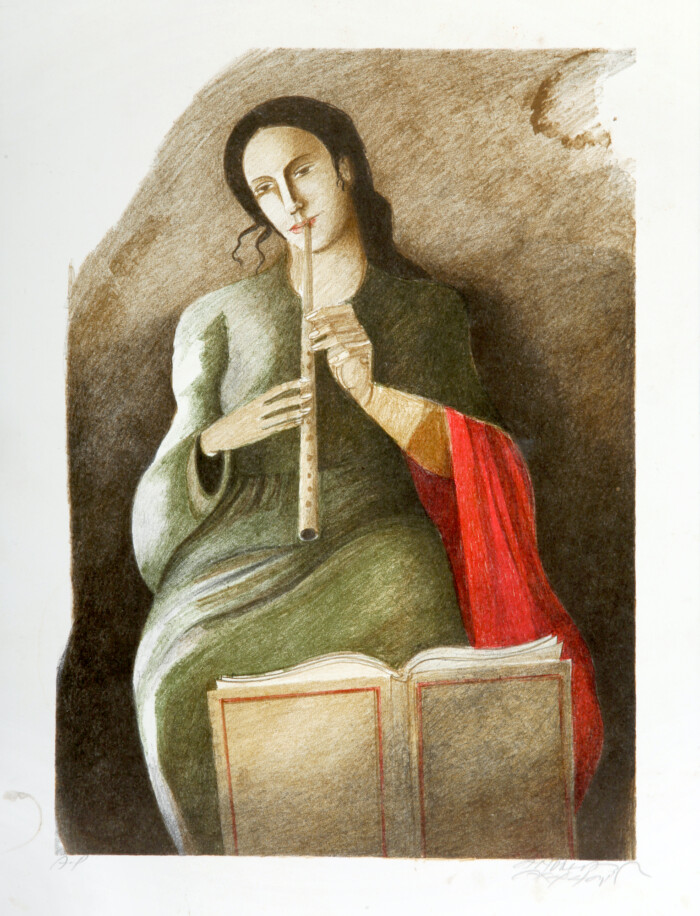Cypriot, b.1938
Girl with flute
silkscreen on paper
signed lower right
annotated a.p (artist’s proof) lower left
48 x 35 cm
unframed
| 120 € | |
Charalambides studied at the Royal College of Art under Sir Terry Frost, RA and has since been developing a career of international standing, based in his native historical town of Paphos. He has built a reputation as a figurative painter of the Cypriot generation of the 1960’s.
His paintings are composed and executed with the skill of an Old Master, yet they are unmistakably modern. He has forged his own unique pictorial language, which is essentially steeped in the diachronic Mediterranean culture. The Italian 16th and the Dutch 17th century, the early works of Picasso and Modigliani, the Medieval frescoes and mosaics of Sienna and Paphos and most of all the myths and legends of Hellenism are his main points of reference. His imagery and atmosphere bear an element of magic, an archetypal metaphysical energy, articulated with frugal forms and a strict palette where golds and browns are used to model and accentuate selected details and key figures.
Charalambides held a large number of solo and participated in many group exhibitions in Athens, Nicosia, London, Alexandria, Beirut, Baghdad, Kuwait, New Delhi, Amsterdam and New York.
His work can be found in many public and private collections in Cyprus and abroad. Notably at the State Gallery of Contemporary Cypriot Art, the Limassol Municipal Gallery, the Paphos Municipal Gallery, the Bank of Cyprus Cultural Centre Foundation, the Central Bank of Cyprus Art Collection and the Archibishop Makarios III Foundation-Cultural Centre.
Quoting art historian and critic prof. Haris Kampourides:
‘In the eyes of the spectator, Andreas Charalambides’s pictures exercise an immediate excitement, as if they portray a deep and well lived dream. His figures stand like sculpture in a posture long-since decided, caught in their destiny. The colours give them light and make them project from the darkness like revelations. The whole atmosphere has an element of magic something metaphysical, and yet familiar, known from long ago. The painter designs every picture with the aim of winning the soul-felt participation of his spectator before anything else. And he succeeds in this.
Later the time comes to sustain a narrative. Quietly, with a slow rhythm of time from other epochs, from one work to another, Charalambides unfolds his stories. Figures of young women holding musical instruments or fruit and plants (more rarely javelins and other instruments), either alone or in composition with internal spaces according to rule. Their glance is seldom towards the spectator and they are usually in a posture of resoluteness, recollection, fixed gaze. As if in a significant interval of a scene which is unfolding, as a segment of halted time, outside the things of this world.
The dresses of these female forms are unaffected gowns, painted so that the fabric seems to be three-dimensional like woven armor which nevertheless does not take away their feminine characteristics. The light which illumines every painted scene does not seem to have a physical origin, but to be transcendental.
A figurative world as a strange as it is alluring is formed in the eyes of the spectator. The persons and their situations are known, but at the same time with an intense feeling of temporal distance, as if they were from the distant past. The painter speaks about immediate phenomena. But it would be truer to say that he speaks to us about their symbolism, the ancient myths- ancient Greek but also from later periods-as he hints that they live and have their being behind every coinciding of human beings and symbols.
He speaks about existence in this world. But he traces it back to its archetypes, to an idealized state.’
